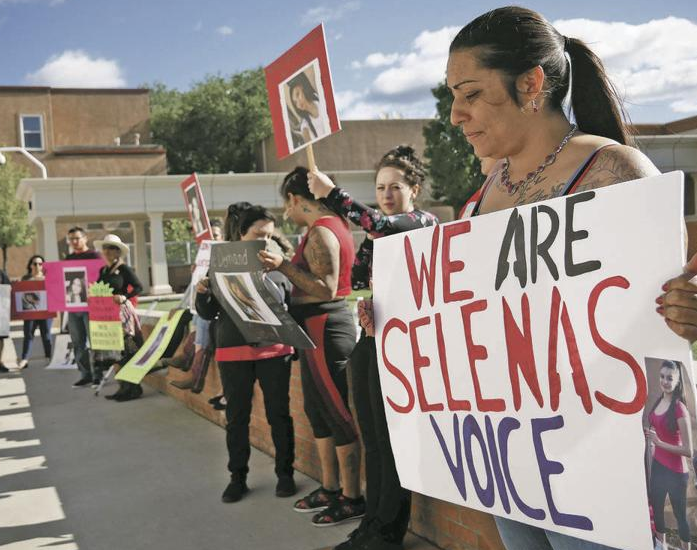Jennifer Burrill, vice president of the New Mexico Criminal Defense Lawyers Association, said a third-party audit is a step in the right direction for the department.
January 4, 2020
More than six months after the Santa Fe Police Department told the District Attorney’s Office it had lost evidence in a first-degree murder case, it’s still unknown how many other cases may have been affected by the agency’s poor evidence handling practices.
The department is awaiting the results of an evidence room audit conducted by SCS Northwest Consulting Services LLC, Deputy Chief Ben Valdez said. Until then, he added, it will not attempt to determine if more evidence is missing.
“We don’t want to go haphazardly down and start going through boxes and potentially compromise additional cases,” Valdez said.
He does not know when the audit will be released, but he expects it soon.
The evidence room came under scrutiny last year after authorities discovered there was evidence missing in the case of Christopher Garcia, 28, accused of fatally stabbing his girlfriend, 21-year-old Selena Valencia, in 2017.
A court-ordered audit of evidence in the Garcia case, conducted by Santa Fe County Sheriff’s Office crime scene technician Shari Vialpando, showed the department failed to follow 14 of its own evidence-handling policies and procedures.
Without the key evidence, state attorneys prosecuting Garcia declined to take him to trial on the first-degree murder charge. Instead, they agreed to a deal that allowed Garcia to plead no contest to a charge of voluntary manslaughter, two counts of possession of a controlled substance and two counts of tampering with evidence. He was sentenced to 12 years in prison.
In another case affected by Santa Fe police’s evidence-handling practices, Wacey Chico was acquitted last month on a charge of attempted second-degree murder. He had been accused of trying to disembowel a homeless man at Fort Marcy Ballpark in 2017.
As the police department awaits results of the audit by SCS Northwest, along with recommendations to correct problems in its evidence room, it already has begun to make some of the changes recommended in Vialpando’s report, Valdez said.
First, he said, it is sending all three of its evidence room technicians and Lt. Sean Strahan to evidence management training. The technicians also now have the authority to reject submissions of evidence if any of the forms or tags are left blank or contain the wrong information, he said.
“Another thing is, let’s say someone collects evidence [and] they don’t submit it,” Valdez said. “We do a vehicle inspection and we find it in the trunk of a car.”
If such mistakes continue, he said, an employee could be disciplined.
SCS Northwest also will determine after the department implements recommended changes if it qualifies for accreditation through the International Association for Property and Evidence Inc., Valdez said.
“We are taking a hard look at the process,” the deputy chief said. “We are not going to be wishy-washy and say we do not need to improve.”
Jennifer Burrill, vice president of the New Mexico Criminal Defense Lawyers Association, said a third-party audit is a step in the right direction for the department. But she said the bigger issue is police officers cannot now ensure the reliability of any of their evidence.
“[Police] are the ones collecting the evidence, and they’re the ones storing the evidence,” Burrill said. “They’re the ones who decide if the evidence gets tested for anything like fingerprints or DNA or anything like that. … So if it is not stored properly before it is tested, then it is not reliable, right? And then how can justice be done if we can’t rely on the evidence that they collect and preserve?”
Aside from Garcia and Chico’s cases, she said, she is not aware of any other cases affected by the evidence issues.
Chico’s attorney, Michael Jones, said the acquittal was a win for his client but also showed how much the police department needed to improve its investigation and evidence-handling procedures.
Jones said during Chico’s trial that the department lost T-shirts worn by the victim and only tested four of the 50 blood samples officers collected at the scene.
After the department receives the audit report, Valdez said, it will look at changing its evidence room policies and procedures and ensuring all staff — not just those working in the evidence room — follow them correctly.
It’s unclear how much money the city is spending on the SCS Northwest audit. According to an Oct. 2 news release, the department requested funding for an independent evidence audit and accreditation assessment. The news release does not say how much money the department requested.
The department has not yet released a copy of its contract with the auditing firm, requested last week through the state Inspection of Public Records Act.
When asked for the total cost of the audit, department spokesman Greg Gurulé wrote in an email Friday that he could not provide any further information about the contract.
Addressing the evidence room issues also will come with a price for new equipment and additional staff.
“There’s going to be, you know, an attached cost for some of the changes,” Valdez said. “And sometimes, you know, the old saying goes, you can either pay now or pay later.”
Industry standard software, which uses bar codes to label and track evidence, can cost $200,000 upfront, along with a $5,000 to $15,000 annual maintenance fee, Valdez said.
He also wants to double the evidence room staff. It’s unclear how the department will pay for such changes.
But Valdez said the investments are necessary to regain the community’s trust.
“We want to do good by our community and have the confidence of our community,” Valdez said. “We saw the Selena Valencia case. We took that to heart.”
Show what you’re thinking about this story


